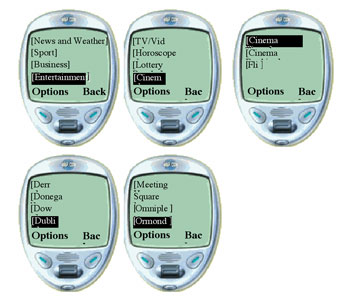| |
The Missing Link - User-Experience and Incremental Revenue Generation on the Mobile Internet
by Barry Smyth
Intelligent navigation and personalization technology developed by ChangingWorlds and University College Dublin’s SmartMedia Institute has proven to significantly enhance the mobile user experience, drive usage and take-up, and so increase data-services revenues for mobile operators.
Paradoxically, the mobile Internet represents both a dramatic step forward and a significant step backward from an information access standpoint. While it offers users greater access to valuable information and services 'on the move', mobile handsets are hardly the ideal access device in terms of their screen-size and input capabilities. As a result, Mobile Internet users are often frustrated by how difficult it is to quickly access the right information at the right time. In our research we have pioneered the use of artificial intelligence and personalization techniques to provide practical solutions to these access problems and our technology is now deployed with leading European operators. Specifically, the ClixSmart NavigatorTM product-suite, developed by ChangingWorlds Ltd. (www.changingworlds.com), provides mobile operators with a complete multi-access, portal platform that includes patented intelligent navigation services that automatically learn about user preferences in order to automatically adapt the structure of a portal for the individual user. ClixSmart Navigator can reduce content access times by 50%, significantly improving usability, and so leading to direct increases in mobile usage.
The Mobile Navigation Problem
The core usability problem with Mobile Internet services (such as WAP portals) is that users spend a significant time navigating to content through a series of menus (see Figure). Recent research highlights the scale of this problem and the mismatch between user expectations and realities. One study claims that while the average user expects to be able to access content within 30 seconds, the reality is closer to 150 seconds. WAP navigation effort can be usefully modelled as click-distance – the number of menu selections and scrolls needed to locate a content item. A recent analysis of 20 European mobile portals reports an average click-distance in excess of 16. In other words, a typical European mobile user can expect to have to make 16 clicks (scrolls and selects) to navigate from their portal home page to a typical content target. Moreover, on average, European portals are organised such that less than 30% of content sites are within 10-12 clicks of the portal home page; 10-12 clicks corresponds to a navigation time of about 30 seconds, which is the tolerable limit for most users. In other words, more than 70% of mobile portal content is essentially invisible to users because of its positioning within its parent portal.
The Personalization Solution
Large click-distances are a fundamental feature of a 'one size fits all' approach to portal design and even optimising a menu structure for the needs of some imaginary 'average user' is unlikely to benefit individuals. However, instead of presenting the same portal to each and every user it is possible to use personalization techniques to learn about the preferences of individual users and to strategically adapt the structure of the portal on a user-by-user basis.
 |
| A sample navigation sequence on a WAP portal: accessing the Ormonde Cinema site takes 16 clicks (scrolls and selects) from the portal home page. |
ClixSmart Navigator adopts a collaborative, probabilistic approach to personalization. Individual user accesses are tracked and used to generate comprehensive user profiles that reflect the user’s portal access patterns (the services they access, when, and how often), their access-device characteristics, and various temporal data. These profiles are used to develop a probabilistic access model for each user that is capable of estimating the probability that a user will access an option, o (which could be another portal menu or content page), given that they are currently viewing portal menu, m. This in turn allows ClixSmart Navigator to personalize static portal menus by reordering their default links based on the target user’s access probabilities and by promoting new links that are likely destination targets for this user.
Over time the portal structure gradually adapts to the access patterns of an individual user. For example, a regular movie goer may find that, at the weekend, their local cinema has been promoted to their portal home page. Of course, it is vitally important that any restructuring takes place in a fashion that makes sense to the user. Rapid changes in portal structure can confuse the user rather than assist them, and as such ClixSmart Navigator contains a range of features to control the speed and scope of perosnalization in order to maximise the benefits to the end-user.
The Benefits
ClixSmart Navigator is currently deployed on the Vodafone (Ireland) and O2 (Germany) networks and is under evaluation by a range of European mobile operators. To date the benefits to the end users, mobile operators, and content providers are clear and compelling. For example, extensive evaluations have proven that ClixSmart Navigator’s intelligent navigation can reduce navigation effort by up to 50% within 4 weeks. Moreover, for every one second of navigation time that is saved, the average user engages in additional 3 seconds of content time. This translates into significant increases in overall airtime (20%+), page impressions (30%+) and data download volumes (30%+) when compared to control-group usage.
Link:
http://www.changingworlds.com/
Please contact:
Barry Smyth ChangingWorlds, Dublin and University College Dublin
E-mail: barry.smyth@ucd.ie
|



